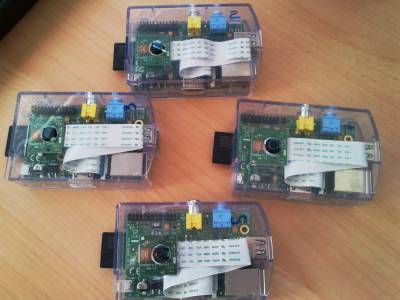User Tools
Site Tools
Site Tools
Raspberry Pi related projects
Time-laps of Computer installation
I used sftp to store data in this configuration. After few weeks of usage, it turns to be a bad idea (everything “freeze” when the server is not responding). Prefer NFS or other remote storage system.
Here is a cheap way to make a time-laps of a new supercomputer installation. We have here 1 central computer (saving photos) and 4 raspberry pi with camera module.
+------------+------------+------------+------------+
| 10.0.0.2 | 10.0.0.3 | 10.0.0.4 | 10.0.0.5 |
PC --+ Pi+Cam Pi+Cam Pi+Cam Pi+Cam
10.0.0.1
Each raspberry will mount a repertory on PC (10.0.0.1) using the simple sshfs at boot, and write each capture on it (to save SD cards from intensive write). First install the PC (I used a Xubuntu 14.04) and create directories where photos will be written :
mkdir /home/pcuser/photos mkdir /home/pcuser/photos/cam2 mkdir /home/pcuser/photos/cam3 mkdir /home/pcuser/photos/cam4 mkdir /home/pcuser/photos/cam5
Now the Pi. We will setup a single pi, and duplicate it's SD card on others.
Note : to write image to sdcard, use (same in reverse order for backup) :
dd if=/path/to/downloaded.img of=/dev/devicenode bs=1M
Default raspbian image does not have sshfs installed, so you will need to download few packages on a raspberry :
sudo apt-get install sshfs
You will also need to configure network and use raspi-config to expand file system. (lot of documentation on the web). Use also this tool to activate camera module. To get more informations on how to setup the camera module : http://www.linuxuser.co.uk/tutorials/pi-camera-quick-installation-guide
To configure date (assuming you can reach web from each pi) :
sudo dpkg-reconfigure tzdata reboot
Make the directory were we will mount :
mkdir /home/pi/out
Now, we need to activate non pass-phrase ssh keys to ssh connect from pi to PC. Note that it is a security risk, I assume you now these risks. Generate a key using ssh-keygen (do not enter anything, just press enter for each question):
ssh-keygen -t dsa
Now, copy the content of /home/pi/.ssh/id_dsa.pub of each pi in /home/pcuser/.ssh/authorized_keys to let pi connect to PC without using a password. Try connecting to check.
OK, we need to setup a script that will mount this directory at startup using the user pi and not root (sshfs does not support multiusers). Create a new file in /etc/init.d called “sshfsmount” and add this :
#! /bin/sh
# /etc/init.d/sshfsmount
#
# Some things that run always
touch /var/lock/sshfsmount
# Carry out specific functions when asked to by the system
case "$1" in
start)
echo "Starting script sshfsmount "
su -l pi -c "sshfs pcuser@10.0.0.1:/home/pcuser/photos/cam2 /home/pi/out
;;
stop)
echo "Stopping script sshfsmount"
fusermount -u /home/pi/out
;;
*)
echo "Usage: /etc/init.d/sshfsmount {start|stop}"
exit 1
;;
esac
exit 0
(more informations here : http://www.debian-administration.org/article/28/Making_scripts_run_at_boot_time_with_Debian)
Now activate it at startup and reboot :
sudo update-rc.d sshfsmount defaults sudo reboot
Login and check if all goes well :
df Filesystem 1K-blocks Used Available Use% Mounted on rootfs 14988412 2159696 12174504 16% / /dev/root 14988412 2159696 12174504 16% / devtmpfs 187320 0 187320 0% /dev tmpfs 38300 208 38092 1% /run tmpfs 5120 0 5120 0% /run/lock tmpfs 76580 0 76580 0% /run/shm /dev/mmcblk0p1 57288 9656 47632 17% /boot pcuser@10.0.0.1:/home/pcuser/photos/cam2 132517248 92928 125669712 1% /home/pi/out
Last thing is to test camera module and set captures in crontab. Try a capture using (You have here 2 formats of files, use the one you want, note that this is absolutely not optimized):
file=$(date +%s).png fileof=$(date +%Y%m%d%H%M%S).png raspistill -o out/$file cp out/$file out/$fileof
If it goes well, create the script /home/pi/capture :
#!/bin/bash file=$(date +%s).png fileof=$(date +%Y%m%d%H%M%S).png raspistill -o out/$file cp out/$file out/$fileof
Make it executable with chmod +x and add it in the crontab of user pi using “crontab -e” (here each 15s):
* * * * * /home/pi/capture * * * * * sleep 15; /home/pi/capture * * * * * sleep 30; /home/pi/capture * * * * * sleep 45; /home/pi/capture
Reboot, this should be good now, check if photos are present on PC in /home/pcuser/photos/cam2. Power of the pi, save the SD card into an image to replicate this image on other pi. Now boot each pi separately, and edit the sshfsmount script to set the correct /home/pcuser/photos/cam? directory and edit network configuration to set the correct ip.
Done. Cheap and easy.
